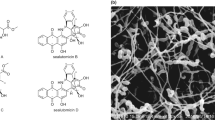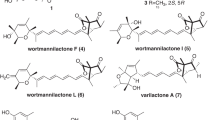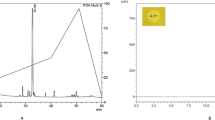Abstract
Natural products along with their analogs have been intensively explored for their antimicrobial potential against ‘ESKAPE’ pathogens. Herein, we report a new natural product with strong antibacterial activity, sulfoxanthocillin (1), along with its decomposed product peniformamide (2), and the known compound xanthocillin X (3) from the deep-sea derived Penicillium sp. SCSIO sof101. The structures of compounds 1 and 2 were determined by extensive spectroscopic analysis. Compound 1 showed significant activity against series pathogens with MIC values ranging 0.06–8.0 μg mL−1. As an artificial unnatural product during the isolation process, compound 2 had lower antimicrobial activity than that of compound 1, which could be attributed to a change in structural modification from an isonitrile group in compound 1 to a formamide group in compound 2. In terms of cytotoxicity, 1 showed relatively low cytotoxicity against human tumor cell lines compared with xanthocillin X (3), suggesting that the sulfate group present in 1 should be a determinant of cytotoxic activities. Overall, sulfoxanthocillin (1) merits further attention as a potential lead compound for anti-infective interventions against Gram-negative and Gram-positive bacterial pathogens.
This is a preview of subscription content, access via your institution
Access options
Subscribe to this journal
Receive 12 print issues and online access
$259.00 per year
only $21.58 per issue
Buy this article
- Purchase on Springer Link
- Instant access to full article PDF
Prices may be subject to local taxes which are calculated during checkout




Similar content being viewed by others
References
Newman DJ, Cragg GM. Natural products as sources of new drugs over the nearly four decades from 01/1981 to 09/2019. J Nat Prod. 2020;83:770–803.
Boucher HW, Talbot GH, Bradley JS, Edwards JE, Gilbert D, Rice LB, Scheld M, Spellberg B, Bartlett J. Bad bugs, no drugs: no ESKAPE! An update from the infectious diseases society of america. Clin Infect Dis. 2009;48:1–12.
Imai Y, Meyer KJ, Iinishi A, Favre-Godal Q, Green R, Manuse S, Caboni M, Mori M, Niles S, Ghiglieri M, Honrao C, Ma X, Guo JJ, Makriyannis A, Linares-Otoya L, Böhringer N, Wuisan ZG, Kaur H, Wu R, Mateus A, Typas A, Savitski MM, Espinoza JL, O'Rourke A, Nelson KE, Hiller S, Noinaj N, Schäberle TF, D'Onofrio A, Lewis K. A new antibiotic selectively kills Gram-negative pathogens. Nature 2019;576:459–64.
Lack of new antibiotics threatens global efforts to contain drug-resistant infections. 2020, https://www.who.int/news-room/detail/17-01-2020-lack-of-new-antibiotics-threatens-global-efforts-to-contain-drug-resistant-infections.
Prioritization of pathogens to guide discovery, research and development of new antibiotics for drug-resistant bacterial infections, including tuberculosis. 2017, https://www.who.int/publications/i/item/WHO-EMP-IAU-2017.12.
Pendleton JN, Gorman SP, Gilmore BF. Clinical relevance of the ESKAPE pathogens. Expert Rev Anti Infect Ther. 2013;11:297–308.
Rothe W. The new antibiotic xanthocillin. Dtsch Med Wochenschr. 1954;79:1080–1.
Takatsuki A, Suzuki S, Ando K, Tamura G, Arima K. New antiviral antibiotics; xanthocillin X mono- and dimethylether, and methoxy-xanthocillin X dimethylether. I. Isolation and characterization. (Studies on antiviral and antitumor antibiotics. V). J Antibiot. 1968;21:671–5.
Yamaguchi T, Miyake Y, Miyamura A, Ishiwata N, Tatsuta K. Structure-activity relationships of xanthocillin derivatives as thrombopoietin receptor agonist. J Antibiot. 2006;59:729–34.
Tsunakawa M, Ohkusa N, Kobaru S, Narita Y, Murata S, Sawada Y, Oki T. BU-4704, a new member of the xanthocillin class. J Antibiot. 1993;46:687–8.
Lim FY, Won TH, Raffa N, Baccile JA, Wisecaver J, Rokas A, Schroeder FC, Keller NP. Fungal isocyanide synthases and xanthocillin biosynthesis in Aspergillus fumigatus. Mbio 2018;9:e00785–18.
Itoh J, Takeuchi Y, Gomi S, Inouye S, Mikawa T, Yoshikawa N, Ohkishi H. MK4588, a new antibiotic related to xanthocillin. J Antibiot. 1990;43:456–61.
Isaka M, Boonkhao B, Rachtawee P, Auncharoen P. A xanthocillin-like alkaloid from the insect pathogenic fungus Cordyceps brunnearubra BCC 1395. J Nat Prod. 2007;70:656–8.
Hübner I, Shapiro JA, Hoßmann J, Drechsel J, Hacker SM, Rather PN, Pieper DH, Wuest WM, Sieber SA. Broad spectrum antibiotic xanthocillin X effectively kills Acinetobacter baumannii via dysregulation of heme biosynthesis. ACS Cent Sci. 2021;7:488–98.
West AV, Woo CM. Ironing out new antibiotic mechanisms with Xanthocillin X. ACS Cent Sci. 2021;7:403–5.
Song Y, Yang J, Yu J, Li J, Yuan J, Wong NK, Ju J. Chlorinated bis-indole alkaloids from deep-sea derived Streptomyces sp. SCSIO 11791 with antibacterial and cytotoxic activities. J Antibiot. 2020;73:542–7.
Sun C, Liu Z, Zhu X, Fan Z, Huang X, Wu Q, Zheng X, Qin X, Zhang T, Zhang H, Ju J, Ma J. Antitubercular ilamycins from marine-derived Streptomyces atratus SCSIO ZH16 △ilaR. J Nat Prod. 2020;83:1646–57.
Dong Y, Ding W, Sun C, Ji X, Ling C, Zhou Z, Chen Z, Chen X, Ju J. Julichrome monomers from marine gastropod mollusk-associated Streptomyces and stereochemical revision of julichromes Q3-5 and Q3-3. Chem Biodivers. 2020;17:e2000057.
Luo M, Cui Z, Huang H, Song X, Sun A, Dang Y, Lu L, Ju J. Amino acid conjugated anthraquinones from the marine-derived fungus Penicillium sp. SCSIO sof101. J Nat Prod. 2017;80:1668–73.
Zuck KM, Shipley S, Newman DJ. Induced production of N-formyl alkaloids from Aspergillus fumigatus by co-culture with Streptomyces peucetius. J Nat Prod. 2011;74:1653–7.
Song Y, Li Q, Liu X, Chen Y, Zhang Y, Sun A, Zhang W, Zhang J, Ju J. Cyclic hexapeptides from the deep south china sea-derived Streptomyces scopuliridis SCSIO ZJ46 active against pathogenic Gram-positive bacteria. J Nat Prod. 2014;77:1937–41.
CLSI. Methods for dilution antimicrobial susceptibility tests for bacteria that grow aerobically; approved standard. 9th ed. CLSI document M07-A9. Wayne, PA: Clinical and Laboratory Standards Institute; 2012.
Ding B, Yuan J, Huang X, Wen W, Zhu X, Liu Y, Li H, Lu Y, He L, Tan H, She Z. New dimeric members of the phomoxanthone family: phomolactonexanthones A, B and deacetylphomoxanthone C isolated from the fungus Phomopsis sp. Mar Drugs. 2013;11:4961–72.
Acknowledgements
This research was funded by National Natural Science Foundation of China (22077128, 22037006, U2106207), Guangdong Provincial Marine Economic Development (Six Major Marine Undertakings) Special Fund Project (GDNRC[2021]54), Key-Area Research and Development Program of Guangdong Province (2020B1111030005), Key Science and Technology Project of Hainan Province (ZDKJ202018), Major Project of Basic and Applied Basic Research of Guangdong Province (2019B030302004), Local Innovation and Entrepreneurship Team Project of Guangdong (2019BT02Y262) and Open Programe of Shenzhen Bay Laboratory (SZBL2021080601006). We thank the analytical facility center of the South China Sea Institute of Oceanology. In particular, we acknowledge Dr. Zhihui Xiao and Dr. Xiaohong Zheng for recording NMR data, and Ms. Aijun Sun, Ms. Yun Zhang, and Xuan Ma for acquisition of HRESIMS data. Additionally, we acknowledge Professor Chang Chen for his kind gifts of pathogenic bacteria Vibrio sp. strains, Professor Jianhua Liu from South China Agricultural University and Professor Nai-Kei Wong from the third People’s Hospital of Shenzhen for the gifts of other pathogenic bacteria.
Author information
Authors and Affiliations
Corresponding authors
Ethics declarations
Conflict of interest
The authors declare no competing interests.
Additional information
Publisher’s note Springer Nature remains neutral with regard to jurisdictional claims in published maps and institutional affiliations.
Supplementary information
Rights and permissions
Springer Nature or its licensor (e.g. a society or other partner) holds exclusive rights to this article under a publishing agreement with the author(s) or other rightsholder(s); author self-archiving of the accepted manuscript version of this article is solely governed by the terms of such publishing agreement and applicable law.
About this article
Cite this article
Yang, J., Song, Y., Zhou, Z. et al. Sulfoxanthicillin from the deep-sea derived Penicillium sp. SCSIO sof101: an antimicrobial compound against Gram-positive and -negative pathogens. J Antibiot 76, 113–120 (2023). https://doi.org/10.1038/s41429-022-00593-9
Received:
Revised:
Accepted:
Published:
Issue Date:
DOI: https://doi.org/10.1038/s41429-022-00593-9



